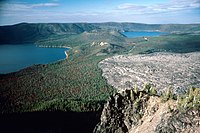
Photo from wikipedia
Abstract The White Pumice (WP) is one of the thickest and most voluminous Plinian fallouts produced by Popocatepetl volcano in central Mexico during the Late Pleistocene-Holocene. Its eruption ~ 23,500 14… Click to show full abstract
Abstract The White Pumice (WP) is one of the thickest and most voluminous Plinian fallouts produced by Popocatepetl volcano in central Mexico during the Late Pleistocene-Holocene. Its eruption ~ 23,500 14 C y BP (27,800 cal BP) was triggered by the catastrophic failure of the SW flank of the volcano. The resulting debris avalanche was highly mobile reaching 72 km from the cone with an apparent coefficient of friction (L/H) of 0.06. The deposit covers an area of ~ 1200 km 2 , and has a volume of 10.4 km 3 . This gigantic landslide, characterized by exceptionally large proximal hummocks (> 400 m) provoked the sudden decompression of the hydrothermal and magmatic systems, which produced an initial blast followed by the rise of a Plinian column that reached an altitude of ~ 33 km. The isopach map allows the recognition of a dispersal axis pointing toward the south, where an area of ~ 2490 km 2 was covered by > 10 cm of pumice and ash. The total volume of the pumice fallout was estimated at ~ 1.9 km 3 DRE (Dense Rock Equivalent). Pumice clasts are dacitic (62–66 wt.% SiO 2 , anhydrous basis), highly vesicular (55–88 vol.%) and display a seriate texture with phenocrysts of plagioclase + hornblende + augite + hypersthene + oxides (Ti-magnetite and ilmenite) + apatite. As the eruption advanced, discharge rates became more intermittent and the height of the column fluctuated and finally collapsed, generating pumice-and-ash flows that were emplaced around the volcano. This short but intense activity was followed during subsequent years by rain-induced lahars that reached great distances from the volcano. At the same time, more degassed andesitic-dacitic (61–65 wt.% SiO 2 ) magma was erupted effusively (4.4 km 3 , DRE) in the new horseshoe-shaped ~ 5 km-wide crater from which the Tochimilco lava flow descended toward the SSE, where it inundated an area of ~ 68 km 2 and reached as far as ~ 22 km from its source. Since then, multiple eruptions have reconstructed the summit cone, almost completely obliterating the horseshoe-shaped crater. During the course of this catastrophic eruption (VEI = 5) a total volume of ~ 6.3 km 3 (DRE) of juvenile magma (pumice and lava) were emitted and at least an additional ~ 10 km 3 of pre-existing rocks (debris avalanche) mobilized. It surpasses in magnitude most other known Plinian eruptions from Popocatepetl and can be envisaged as an example of a worst-case scenario for hazard evaluation purposes. It dramatically changed the morphology of the volcano and had profound and far-reaching effects beyond its immediate vicinity along rivers draining surrounding plains as well as on the lacustrine basins (e.g. Chalco) to the NE. A repeat of such an eruption in this densely populated area would certainly cause a major calamity of unprecedented dimensions.
Journal Title: Journal of Volcanology and Geothermal Research
Year Published: 2017
Link to full text (if available)
Share on Social Media: Sign Up to like & get
recommendations!